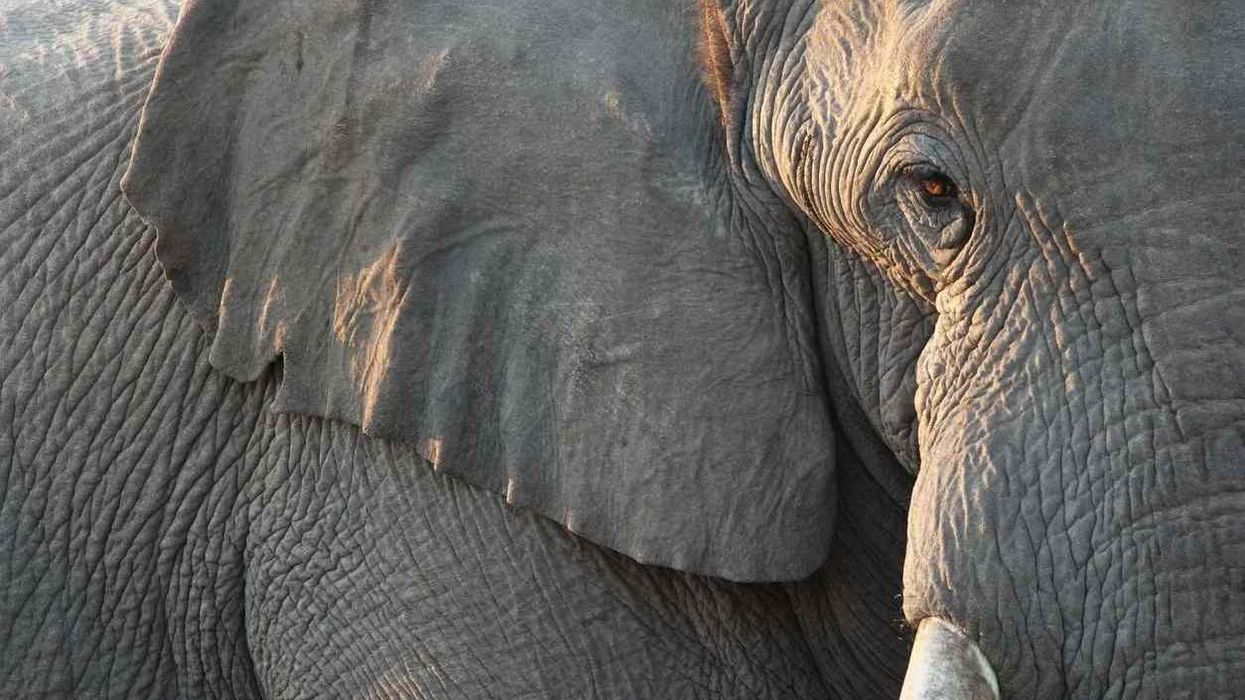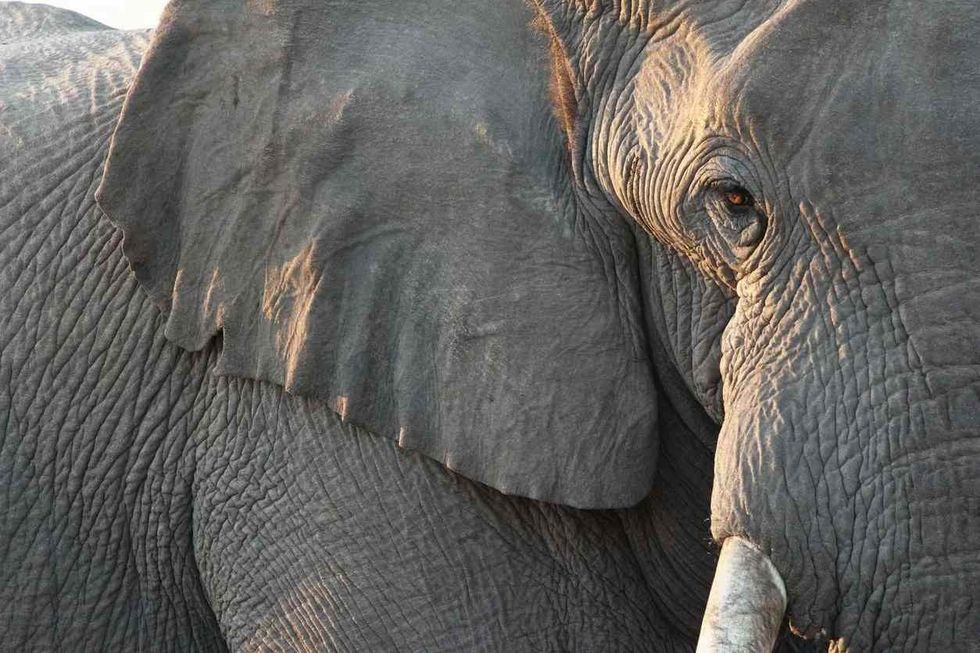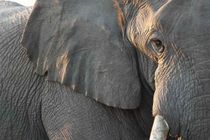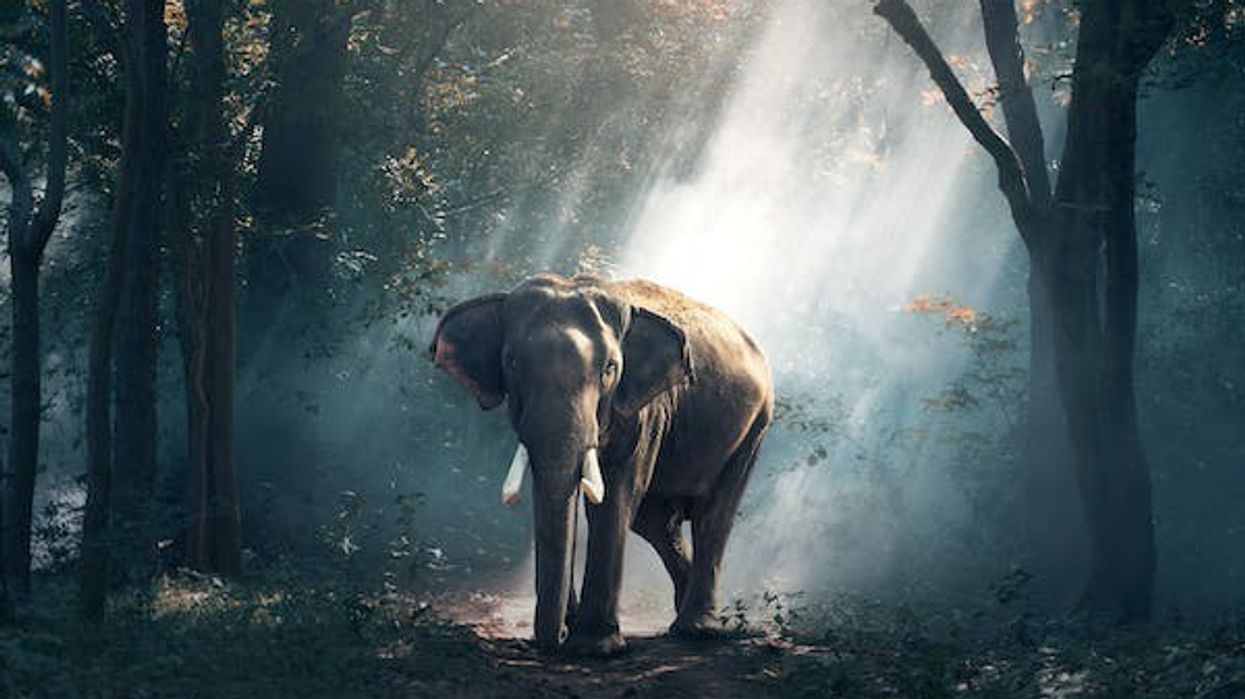Fun Elephants Facts For Kids

Elephants are very peaceful and intelligent animals that have different ranges of emotions, feelings, and compassion as well. They care for each other just like humans do. Elephants are known as the largest land mammals present on Earth.
Elephants have distinctively massive bodies, large ears, and long trunks which they use to pick up objects and also bless people at temples. Elephant populations across the world are steadily declining and concerted efforts for their conservation are required. These creatures are native to Asia and Africa.
Asian elephants have only one sub-species of elephant while the African elephants have two sub-species of elephants which include the African savanna elephant (Loxodonta africana), the African forest elephant (Loxodonta cyclotis), and the Asian elephant (Elephas maximus).
The African and Asian males are 50% heavier than the females, they also weigh more and are very huge in size when compared to other animals. Elephants are considered the most important ecosystem engineers.
Elephants are afraid of mice as they fear that the mouse will crawl up their trunks to bite them and eat their skin.
If you enjoyed these facts about elephants, and want to further explore the animal kingdom, you may also read leopard seal facts and fennec fox facts.
Elephants Interesting Facts
What type of animal are elephants?
Elephants are a type of land animal. Elephants are known to be the largest existing land animals and are divided into three separate species: African savanna elephant (Loxodonta africana), the African forest elephant (Loxodonta africana cyclotis), and the Asian elephant (Elephas maximus).
The African and Asian Elephants are quite different from one another. The Asian Elephant (Elephas maximus) has smaller ears than African elephants, and is smaller in size.
Other than that, only the male Asian elephants have tusks.
On the contrary, both the male and female African elephants have tusks. African elephants (Loxodonta africana) and Asian elephants (Elephas maximus) are large mammals who feed on plants and have a snout that is modified into trunks, and the teeth modified into tusks.
What class of animal do elephants belong to?
Asian elephants and African elephants both belong to the class of mammals. All of the elephants are mammals that belong to the Elephantidae family and are huge in size.
Elephants are known as the world's largest land mammals. The African elephant and Asian elephant are distinguished by their different features which include lengthy trunk, legs, and a huge head with temporal glands, and wide, flat ears.
How many elephants are there in the world?
There are around 440,000 elephants left in the world and the number of Asian elephants and African elephants have subject to a rapid decline over the past several decades.
The species come under the category of Endangered species in the world, and there are several reasons that are responsible for the decline in the number of elephants in the world.
Where do elephants live?
Asian elephants and African elephants (Loxodonta africana) usually prefer to live in savannas, grasslands, and forests. Most of the time they also try to occupy a huge range of habitats which includes tropical and subtropical regions of Africa and Asia, deserts, and swamps.
What is an elephants' habitat?
Asian elephants and African elephants usually prefer to live in diverse habitats that include wetlands, forests, grassland, savanna, and other deserts across 37 countries in southern, eastern, western, and central Africa and Asia. Elephants get their food from the habitat where they live. Elephants are herbivores and find grasses, bushes, and trees in their habitat to feed on.
Who do elephants live with?
Adult Asian elephants and African elephants are solitary creatures, but wild elephants may try to associate with other bulls in small and unstable groups. Male Asian elephants and male African elephants usually leave the family unit between the age of 12 to 15 years.
The female elephants usually live in herds with their daughters, sisters, and their offspring, whereas the male elephants often stay independent.
How long do elephants live?
The lifespan of wild elephants differs from one species to another.
The African elephants can live for about a period of 60 to 70 years and Asian elephants can live for a period of up to 48 years.
The elephants in the wild and elephants who live in captivity (zoos or safari parks) have different lifespans depending on different factors such as a change in environment, surroundings, weather, and many other things that could either increase or decrease their lifespan.
Also, both the Asian elephants and African elephants come under the category of Endangered species, hence all species of wild elephants should be protected.
How do they reproduce?
The male tries to chase the female if she retreats and tries to chase off any other males. Elephants use their trunks in order to stroke each other before the male mounts the female from behind.
They stand vertically as they mate. The females have the ability to mate with more than one bull in each of their estrus cycles, and that can last up to 18 weeks.
The male elephants will try to fight over a potential mate in order to start their mating. The caretakers work to get the female elephants pregnant during their fertilization period.
After the female elephant gets pregnant, the gestation period of the elephant officially begins. The gestation period of the elephants is around 22 months.
What is their conservation status?
The conservation status of Asian elephant and African elephant species is Critically Endangered as elephant populations are declining day-by-day. This rapid decline is due to poaching.
People hunt these creatures for their tusks in order to get ivory.
Loss of habitat is also a huge reason for the decrease in these animals, as areas get more urbanised and climate change effects their habitats, these creatures are losing their home. Human beings are responsible for the Endangered status of elephants as many hunters hunt elephants for their tusks.
There are efforts being made for the conservation of this species as the focus is on maintaining habitat, and creating corridors to connect the areas.
Conservation experts are also trying to improve the laws and protections regarding the trade of tusks for ivory. There are different laws that are in place for the protection of this Endangered species as the elephant populations are declining due to various factors.
Elephants Fun Facts
What do elephants look like?
Elephants are the largest land animals on Earth, and they are one of the most unique-looking animals too. Their characteristics are described as having long noses (which are called trunks), large and floppy ears, and wide and thick legs.
There is no other animal that is similar to the elephant’s physique. Forest elephants have columnar legs and huge heads with temporal glands and wide and flat ears. Elephants range in color from grayish to brown, and their body hair is sparse and coarse.
Elephants are one of the very few species that recognize themselves in the mirror very easily. Elephant tusks are present only in Asian male elephants but in both male and female African elephants.
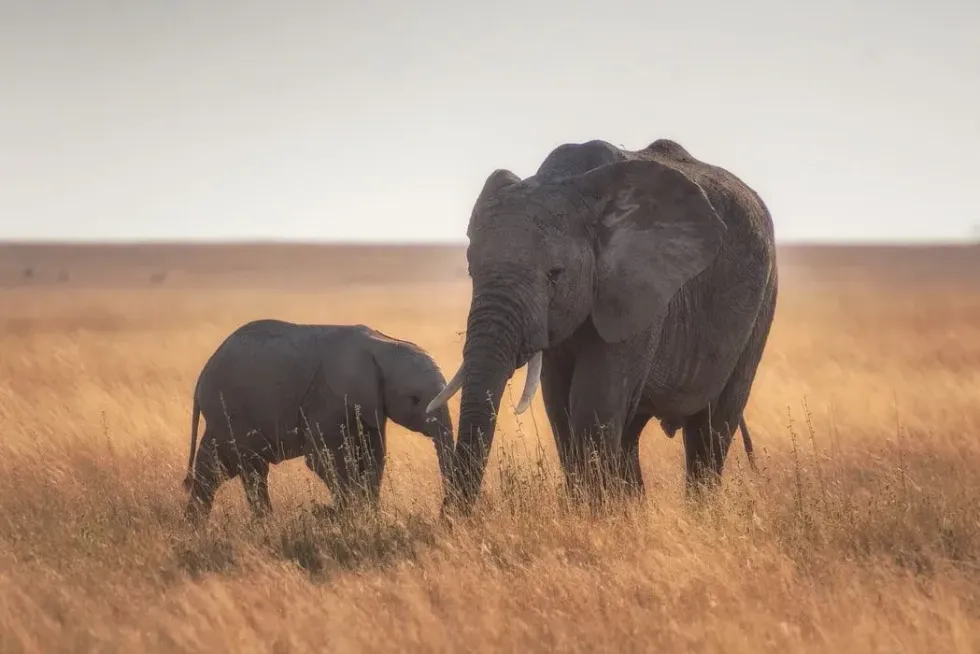
How cute are they?
Elephants are known to be super cute for the way they look. With the help of their little trunks, tusks, and ears, they tend to obsess people and win the hearts of many people. The way they lift their trunk is so adorable.
How do they communicate?
Elephants can communicate by using very low-frequency sounds and pitches that are below the range of human hearing. The low-frequency sounds are known as infrasounds and can travel several kilometers, and also provide the elephant with a private communication channel which is known to play an important role in the elephants’ complex social life.
How big are elephants?
Sri Lankan elephants are quite large and big in size and are known to be the largest land animals. They are the largest existing land animals. The largest of all the elephant species is the African elephant which weighs up to 6,000-13,200 lb (2721-5987 kg).
How fast can Elephants move?
Elephants can run at speeds of about 25 mph (40 kmph). They cannot move fast as they are heavy in weight.
Elephants are so big that it is hard to outrun an elephant by zigzagging. They usually roam around at a leisurely pace due to absence of any serious predators and need to look for food, water, and other essentials.
How much do elephants weigh?
The weight of the elephants differs from one species to another. African bush elephants weigh around 13,200 lb (5987 kg), Asian elephants weigh around 8,800 lb (3991 kg), and African forest elephants weigh around 6,000 lb (2721 kg).
What are the male and female names of the species?
The male elephant is known as a bull elephant, whereas the female elephant is known as a cow.
What would you call baby elephants?
A baby elephant is called a calf. The baby elephants reach maturity in their second year of life. The African elephant stays with the mother until it becomes entirely dependent at the age of three to five years.
What do they eat?
Elephants are herbivores. They eat grasses, small plants, bushes, fruits, twigs, tree bark and roots and move in herds in search of food and water. They are known to be vegetarians.
The adult elephants need up to 300 lb (136 kg) of food in a single day. Water for elephants is essential, not only for drinking but for bathing as well. They use their trunk to lift food to their mouth where their incisor teeth shred it into pieces.
Are they dangerous?
No, elephants are very peaceful and loveable animals, but at the same time can harm humans if they are mistreated. They are the most intelligent mammals that display a different range of emotions.
If any attack takes place, then there are chances that an elephant is quite capable of killing another elephant and there are chances that humans can get killed by their trampling.
Would they make a good pet?
Elephants are highly intelligent animals that have an excellent memory and are sometimes, unfortunately, trained to become performers and working animals. Elephants are not domesticated like dogs and cats, and it is not possible for one individual wild animal to be domesticated for a lifetime.
You cannot pet elephants as they are huge in size and need an open area to roam around and be with their offspring.
They are highly sensitive and caring animals, just like humans. Moreover, as elephant population is declining across South Africa and Asia, efforts for their conservation are eagerly required.
Did you know...
Elephants are pregnant for nearly two years which is much longer than any other animal. The African elephants are smaller when they are born than the Asian elephants, but are much bigger when they grow up as adults.
Their trunk is very powerful, making it easy for them to sense the size, shape, and temperature of an object very easily and quickly.
Five interesting facts about elephants include, that elephants can smell water from 12 miles away. Elephants also spend most of their time foraging every day and spend only two to three hours actually sleeping.
Elephants are the only mammals, other than human beings, who have chins. Elephants have more than 100,000 muscles out of which 40,000 are in their trunk. In fact, the elephant's trunk is the fusion of their upper lip and the nose.
Elephants are afraid of bees, and mice as well as they have the fear that they might end up biting them. These animals also aren't huge fans of fire, and can become quite scared of it.
What is so special about an elephant?
They are highly intelligent animals who have complex emotions, feelings, compassion, and self-awareness. Elephants are one of the few species that can recognize themselves in a mirror. Moreover, they use their tusks for a variety of tasks including digging.
What animals rely on elephants?
Many animals indirectly reply on elephants for their survival, this includes birds, baboons, and antelope. There are also different birds and animals that rely on elephants such as oxpeckers who sit on the elephants while they eat lice and ticks.
Cattle egrets, olive baboons, and antelope also rely on these creatures. Elephants help to maintain the forest and the savanna ecosystem for the other species and are integrally tied to rich biodiversity. Elephants are the most important ecosystem engineers.
Here at Kidadl, we have carefully created lots of interesting family-friendly animal facts for everyone to discover! Learn more about some other mammals including anteater, or plains zebra.
You can even occupy yourself at home by drawing one of our elephant with flowers coloring pages
We Want Your Photos!
More for You
Sources
https://www.worldwildlife.org/species/elephant
https://en.wikipedia.org/wiki/Elephant
https://www.britannica.com/animal/elephant-mammal
https://www.wwf.org.uk/learn/fascinating-facts/elephants
https://a-z-animals.com/animals/elephant/
Bachelor of Science specializing in Microbiology

Oluwatosin MichaelBachelor of Science specializing in Microbiology
With a Bachelor's in Microbiology from the Federal University of Agriculture, Abeokuta, Ogun State, Oluwatosin has honed his skills as an SEO content writer, editor, and growth manager. He has written articles, conducted extensive research, and optimized content for search engines. His expertise extends to leading link-building efforts and revising onboarding strategies.
Bachelor of Arts specializing in English Literature

Deeti GuptaBachelor of Arts specializing in English Literature
A detail-oriented fact-checker with a research-oriented approach. Devika has a passion for creative writing, she has been published on multiple digital publishing platforms and editorials before joining the Kidadl team. Currently pursuing a Bachelor of Arts in English Literature from St.Xavier's College, Deeti has won several accolades and writing competitions throughout her academic career.
Disclaimer
1) Kidadl is independent and to make our service free to you the reader we are supported by advertising. We hope you love our recommendations for products and services! What we suggest is selected independently by the Kidadl team. If you purchase using the Buy Now button we may earn a small commission. This does not influence our choices. Prices are correct and items are available at the time the article was published but we cannot guarantee that on the time of reading. Please note that Kidadl is a participant in the Amazon Services LLC Associates Program, an affiliate advertising program designed to provide a means for sites to earn advertising fees by advertising and linking to Amazon. We also link to other websites, but are not responsible for their content.
2) At Kidadl, we strive to recommend the very best activities and events. We will always aim to give you accurate information at the date of publication - however, information does change, so it’s important you do your own research, double-check and make the decision that is right for your family. We recognise that not all activities and ideas are appropriate for all children and families or in all circumstances. Our recommended activities are based on age but these are a guide. We recommend that these ideas are used as inspiration, that ideas are undertaken with appropriate adult supervision, and that each adult uses their own discretion and knowledge of their children to consider the safety and suitability. Kidadl cannot accept liability for the execution of these ideas, and parental supervision is advised at all times, as safety is paramount. Anyone using the information provided by Kidadl does so at their own risk and we can not accept liability if things go wrong.
3) Because we are an educational resource, we have quotes and facts about a range of historical and modern figures. We do not endorse the actions of or rhetoric of all the people included in these collections, but we think they are important for growing minds to learn about under the guidance of parents or guardians.
